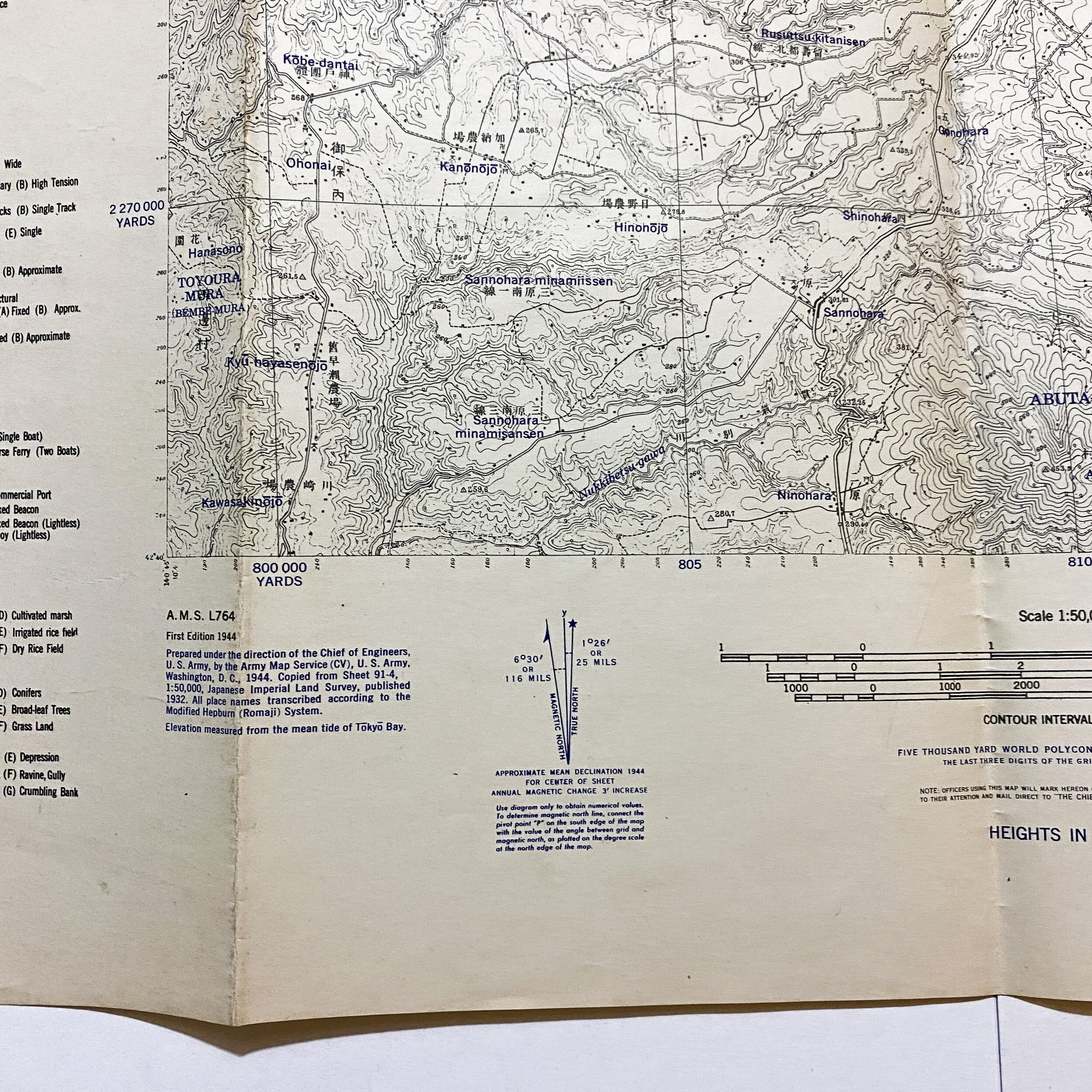1944 First Edition AMS Naval Firing Map of 'Rusuttsu' Hokkaido Japan

















1944 First Edition AMS Naval Firing Map of 'Rusuttsu' Hokkaido Japan
Size: 20 x 26 inches
This original AMS L764, First Edition map was prepared under the direction of the Chief Engineers of the US Army and was utilized towards the end of the war as the US navy inches closer to the main land of Japan. This map was used for firing missions done by the U.S. Naval ships off the coast of Japan and shows yard markers as seen on the sides of the map all marked as being measured from the mean tide at Tokyo Bay. The 1944 map is gridded for triangulation and shows translated Japanese kanji and English text that designates Japanese enemy naval, air and army camps as well as Japanese division headquarters, and other important military targets.
Hokkaido:
On 1 July, TF 38 sailed from Leyte to strike at the Japanese home islands. At this time the Task Force comprised nine fleet carriers, six light carriers and their escorts. Halsey sought to coordinate his fleet's attacks during the last months of the war with those of the USAAF's land-based aircraft, but the two forces often operated separately. On 10 July TF 38's aircraft conducted raids on airfields in the Tokyo region, destroying several aircraft on the ground. No Japanese fighters were encountered in the air, however, as they were being kept in reserve for a planned large-scale suicide attack on the Allied fleet. Following this raid TF 38 steamed north, and began a major attack on Hokkaido and northern Honshu on 14 July. These strikes continued the next day, and sank eight of the 12 railway car ferries which carried coal from Hokkaido to Honshu and damaged the remaining four. Many other ships were also destroyed in this area, including 70 out of the 272 small sailing ships which carried coal between the islands. Once again no Japanese aircraft opposed this attack, though 25 were destroyed on the ground.[182] The loss of the railway car ferries reduced the amount of coal shipped from Hokkaido to Honshu by 80 percent, which greatly hindered production in Honshu's factories. This operation has been described as the single most effective strategic air attack of the Pacific War. TF 38's battleships and cruisers also began a series of bombardments of industrial targets on 14 July which continued until almost the end of the war.
Raids on Japan:
Allied forces conducted many naval and air raids on Japan during World War II, causing extensive destruction to the country's cities and killing between 241,000 and 900,000 people. During the first years of the Pacific War these attacks were limited to the Doolittle Raid in April 1942 and small-scale raids on military positions in the Kuril Islands from mid-1943. Strategic bombing raids began in June 1944 and continued until the end of the war in August 1945. Allied naval and land-based tactical air units also attacked Japan during 1945.
The United States military air campaign waged against Japan began in earnest in mid-1944 and intensified during the war's last months. While plans for attacks on Japan had been prepared prior to the Pacific War, these could not begin until the long-range B-29 Superfortress bomber was ready for combat. From June 1944 until January 1945, B-29s stationed in India staged through bases in China to make a series of nine raids on targets in western Japan, but this effort proved ineffective. The strategic bombing campaign was greatly expanded from November 1944 when bases in the Mariana Islands became available as a result of the Mariana Islands Campaign. These attacks initially attempted to target industrial facilities using high-altitude daylight "precision" bombing, which was also largely ineffective. From February 1945, the bombers switched to low-altitude night firebombing against urban areas as much of the manufacturing process was carried out in small workshops and private homes: this approach resulted in large-scale urban damage. Aircraft flying from Allied aircraft carriers and the Ryukyu Islands also frequently struck targets in Japan during 1945 in preparation for the planned invasion of Japan scheduled for October 1945. During early August 1945, the cities of Hiroshima and Nagasaki were struck and mostly destroyed by atomic bombs.
Japan's military and civil defenses were unable to stop the Allied attacks. The number of fighter aircraft and anti-aircraft guns assigned to defensive duties in the home islands was inadequate, and most of these aircraft and guns had difficulty reaching the high altitudes at which B-29s often operated. Fuel shortages, inadequate pilot training, and a lack of coordination between units also constrained the effectiveness of the fighter force. Despite the vulnerability of Japanese cities to firebombing attacks, the firefighting services lacked training and equipment, and few air raid shelters were constructed for civilians. As a result, the B-29s were able to inflict severe damage on urban areas while suffering few losses.
The Allied bombing campaign was one of the main factors which influenced the Japanese government's decision to surrender in mid-August 1945. However, there has been a long-running debate over the morality of the attacks on Japanese cities, and the use of atomic weapons is particularly controversial. The most commonly cited estimate of Japanese casualties from the raids is 333,000 killed and 473,000 wounded. There are a number of other estimates of total fatalities, however, which range from 241,000 to 900,000. In addition to the loss of mostly civilian life, the raids contributed to a large decline in industrial production.